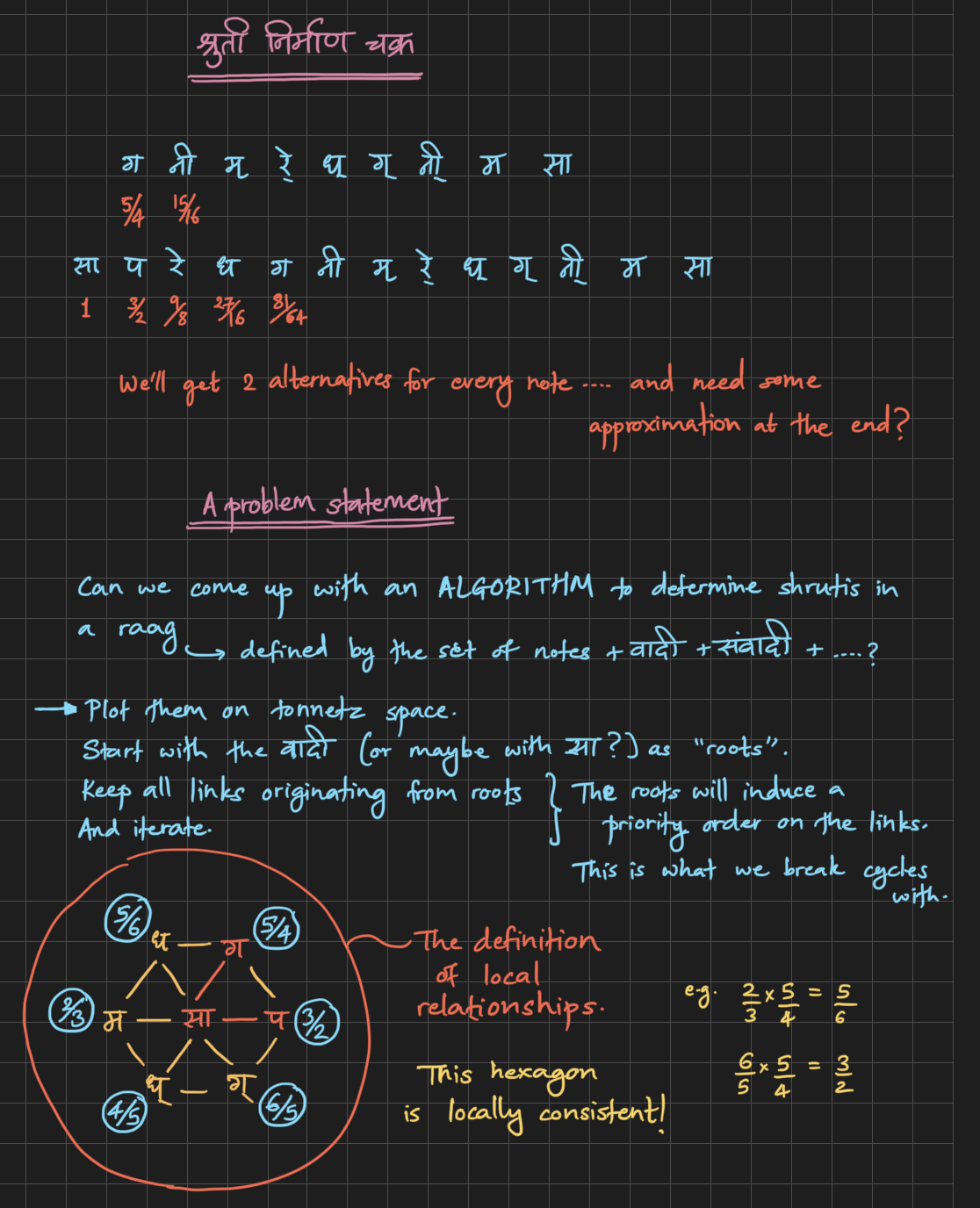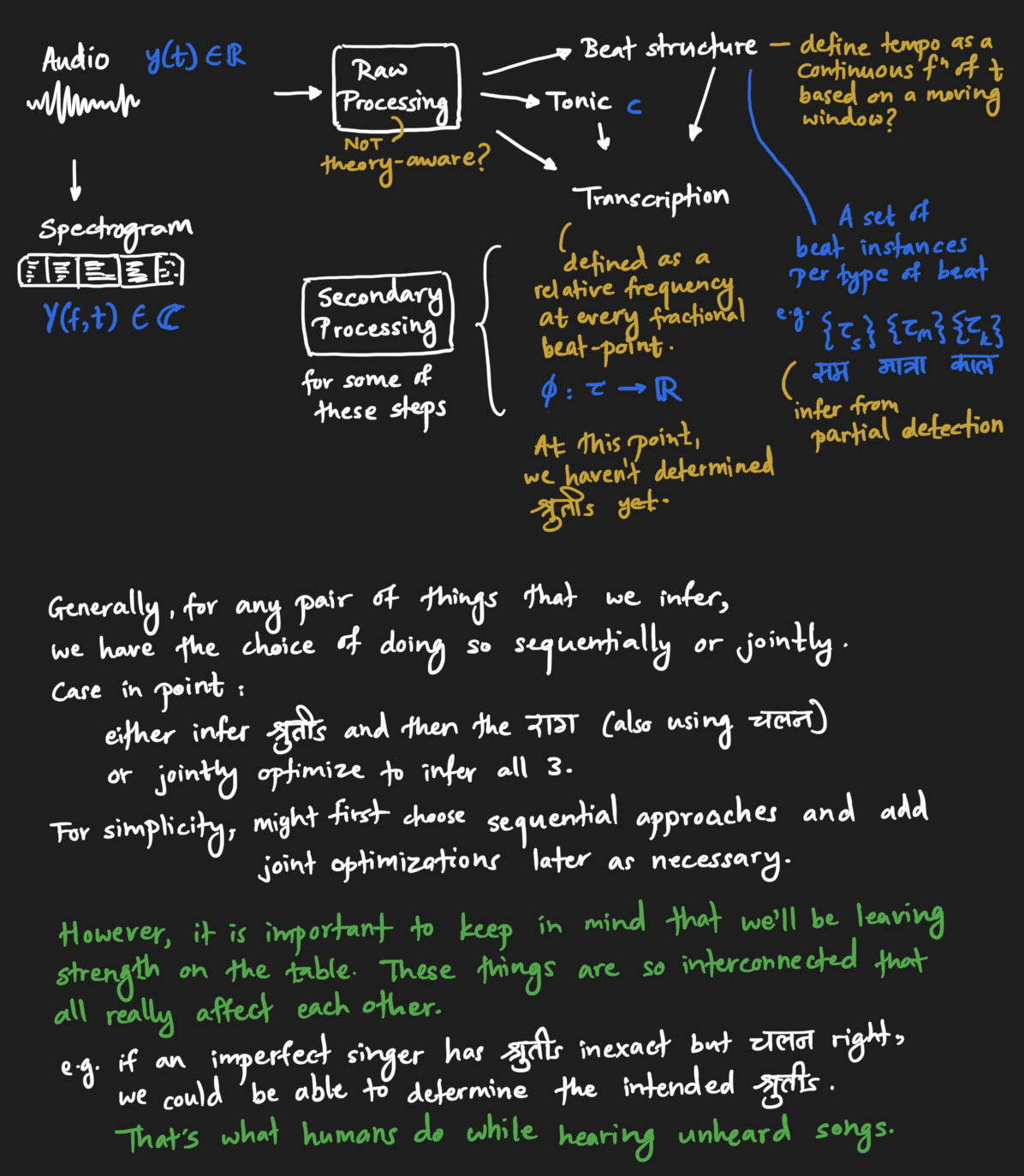shruti determination
[This is a draft article]
मला स्वरांच्या उंचीतला फरक गाता गाता अनेकदा जाणवला आहे. पण ह्याचा थोडाही खोलात अभ्यास करायचा असेल तर त्याला थोड्या विश्लेषणाची जोड देण्याची गरज भासते.
ह्या लेखाचे ३ भाग:
१. एक Hierarchical Frequency Determination Algorithm (HFDA)
२. २२ श्रुती सिद्धांत as-is
३. better proposals
Hierarchical Frequency Determination Algorithm
If one takes the Hexagon shown on the right (note: this hexagon itself is locally consistent, related by simple rations) as a Building Block of the Tonnetz diagram and tries to expand from there to construct an extended Tonnetz diagram, we very quickly run into inconsistencies. We need to approximately stitch together some edges.
The HDH in short states that if one takes only the in-Raag notes from the Tonnetz diagram, the Vaadi/Samvaadi ones will have a higher amount of local consistency around them, and the approximate stitching will happen around less important notes.
Put differently, one arranges the notes & चलनs of a Raag in hierarchical importance and goes down that chart to start assigning frequency values consistent with those already determined.

The 22 Shruti Theory
This theory only recognizes powers of 3 (up to the 5th power!) and powers of 5 (only 1st power!), as integers that can make up “simple” ratios.
[insert extended Tonnetz diagram here]
Computations by some other theorists: https://22shruti.com/research_topic_6.asp
Computations by Dr Oak:
| स्वर | Pure Ratio | Decimal Ratio |
|---|---|---|
| S | 1 | 100 |
| r1 | 256/243 | 105.3497942 |
| r2 | 16/15 | 106.666667 |
| R1 | 10/9 | 111.111111 |
| R2 | 9/8 | 112.5 |
| g1 | 32/27 | 118.51851851 |
| g2 | 6/5 | 120 |
| G1 | 5/4 | 125 |
| G2 | 81/64 | 126.5625 |
| M1 | 4/3 | 133.333333 |
| M2 | 27/20 | 135 |
| m1 | 45/32 | 140.625 |
| m2 | 729/512 | 142.3828125 |
| P1 | 40/27 | 148.148148148 |
| P2 | 3/2 | 150 |
| d1 | 128/81 | 158.0246913 |
| d2 | 8/5 | 160 |
| D1 | 5/3 | 166.666667 |
| D2 | 27/16 | 168.75 |
| n1 | 16/9 | 177.77778 |
| n2 | 9/5 | 180 |
| N1 | 15/8 | 187.5 |
| N2 | 243/128 | 189.84375 |
| S2 😞 | 81/80 | 202.5 |
As mentioned above, this is sort of a hybrid 5-prime-limit ∩ 729-odd-limit system.
-
n-odd-limit = {p/q : there does not exist odd m > n such that m p or m q} -
n-prime-limit = {p/q : there does not exist prime m > n such that m p or m q}
e.g. ratios with a factor of 9 are prohibited in a 7-odd-limit system but allowed in a in a 7-prime-limit system.
A Better Proposal
Set no odd-limits and no prime-limits. Choose the first P prime numbers where P is significantly large (say 8-10) and construct a P-dimensional Tonnetz net.
We will be assigning lower preferences to higher prime axes.*
Now, given the chalan of the raag, choose nodes that minimize path length (or some such metric) while traversing over the net. (*This computation is the place where.) Essentially, travelling along large-prime axes will cost us more. The further we do away from the root as well, it will incur more path cost. In the way, we can enforce a soft prime-limit and odd-limit.
Here’s a roadmap:

If you’re still not sold, consider the MIDI format, which supports a Frequency Data Format that needs far more bits than Equal Temperament MIDI
With the Shruti-Determination Algorithm, for HCM, one would be able to still use 12 notes per octave as an information-efficient file format, and automatically deduce microtonal information from the set of notes + chalan!
References
- https://22shruti.com/research_topic_6.asp
- https://puretones.sadharani.com/learn/musicalscales
- https://en.wikipedia.org/wiki/Fokker_periodicity_block
- https://www.anaphoria.com/wilson.html (works of https://en.wikipedia.org/wiki/Erv_Wilson)
Categories: music
